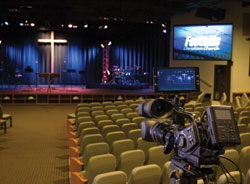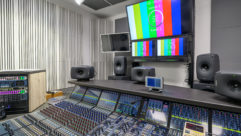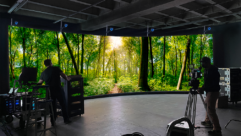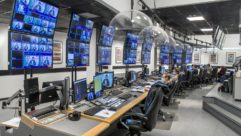

Everyone’s a Broadcaster
In recent years, broadcast technology has evolved so that it’s more accessible to non-traditional markets such as houses of worship, museums, corporations, and even government agencies.
Broadcast technology has become so affordable, houses of worship and others are requiring broadcast capabilities in their AV upgrades.
In recent years, broadcast technology has evolved so that it’s more accessible to non-traditional markets such as houses of worship, museums, corporations, and even government agencies.
“What does the term ‘broadcast’ really mean anymore?” says Pat Thompson, senior vice president and general manager of integrator TV Magic. “Across the board, high quality content is popular because it is economically feasible.”
Frank Giliotti, vice president of technical services for broadcast systems design and integration firm Communications Engineering (CEI), has seen the trend of broadcast technology in AV projects increase over the past three to four years. “This is caused by the desire for high-definition signal filtering down-market. Every client in every market wants the best possible signal,” he explains.
CEI designed and integrated the broadcast system for the Newseum, a high-tech museum in Washington, D.C. Its in-house broadcast studio was designed for use by a variety of broadcasters and has hosted several broadcast TV shows.
However, Thompson points to the house of worship market as the one that really kicked off the AV/broadcasting trend. “Houses of worship are interested in limited broadcasts, such as to a satellite facility or campus. Sometimes they want to send a live feed or tape a service and send the video over IP for same-day delivery,” he says. “Using an AV system to capture and record a service, and then [using] broadcasting equipment to send the service outside your facility means you can create a larger church community.”
Similarly, the marriage of broadcast and AV presentation systems has resonated in the corporate market. Kevin Collins, senior vice president and chief operating officer of Diversified Systems in Kenilworth, N.J., calls these systems “hybrid” systems, and his company has been installing them in corporate facilities since 2000.
“At that time, entities like insurance, financial services, and health care companies wanted to install high-end presentation systems but also have the ability to record at broadcast quality for distribution or archive,” Collins says. “They could also pre-tape a piece and send it to TV stations for use in news segments. By 2006, broadcast equipment started becoming part of the standard for new systems.”
Because of this rush to make every client a broadcaster, AV pros require fresh skills and knowledge. “Video engineers now need to know the difference between standards like H.263 and MPEG-4 Part 10, as well as how to make use of bandwidth,” says Thompson.
“On the integration side, you need a technology and engineering background. It is not plug-and-play,” says Giliotti. “We also look for technicians with broadcast equipment and broadcast environment experience, and for electrical engineers with at least five years in a broadcast environment.”
Collins has brought people in from IT, architectural services, and systems control to join his firm. Those diverse backgrounds help when working with clients like the Mormon Tabernacle Choir, which was already recording its performances but wanted to upgrade to high definition.
“The new system includes the capability for 5.1 surround sound and to produce Blu-ray DVDs,” he says. “Designing and installing the system required expertise in architectural design, broadcast television, as well as presentation technology and image magnification.”
Collins has also noticed that the broadcast and AV line is blurring on the product side, too. “Some presentation products are starting to look like broadcast products, i.e., a switcher versus a production switcher,” he adds. “Some switchers now have production capabilities such as adding feeds, graphics, and previews that are similar to what’s available on the TV side.”
One example is the InfoCaster digital signage product by Harris Broadcast Communications. Though signage and broadcast are two different markets, they tend to blend in facilities like sports arenas that produce and broadcast their own content over their digital signage systems.
“The product has a broadcast backbone,” says Don Hewitt, product manager for InfoCaster. “It is the exact same graphics engine as the broadcast products but with a different interface and less programmer requirements.”
What is Broadcast Quality?
So when has an AV presentation crossed the line into broadcast? It can depend on who you ask.
“Broadcast quality pertains to two things,” says Collins. “The first is image and sound quality, but the second is a more esoteric requirement for the clear differences between high-end presentations versus broadcast productions. Broadcasters have defined standards that are adhered to by vendors. It’s a guarantee to the person receiving the signal that the signal is held at a certain standard.”
Giliotti says that product reliability and a high-quality 1920×1080 HD signal differentiate broadcast from anything else. Hewitt says it’s the ability to add live tickers and dynamic content.
What may help change and crystalize the definition is the Internet, and the increasing interest in broadcasting online. TV Magic’s Thompson says, “New facilities are either thinking of ways to broadcast a video file online or are already doing it. The bandwidth pipe isn’t going to increase dramatically in the next few years, so it is about compression algorithm technology and how to get better video over the same pipe.”
CEI is receiving more inquiries about Web streaming, but for right now, the focus is on HD systems. Giliotti notes that “everything is headed to HD since it is becoming more affordable than ever before. The cost delta between standard definition and high definition is not as steep.”
Says Collins, “We still have room to grow. The market is not saturated, but TV is 50 years old and presentation technology is quickly catching up.”
Linda Seid Frembes is a contributing editor to Pro AV.










